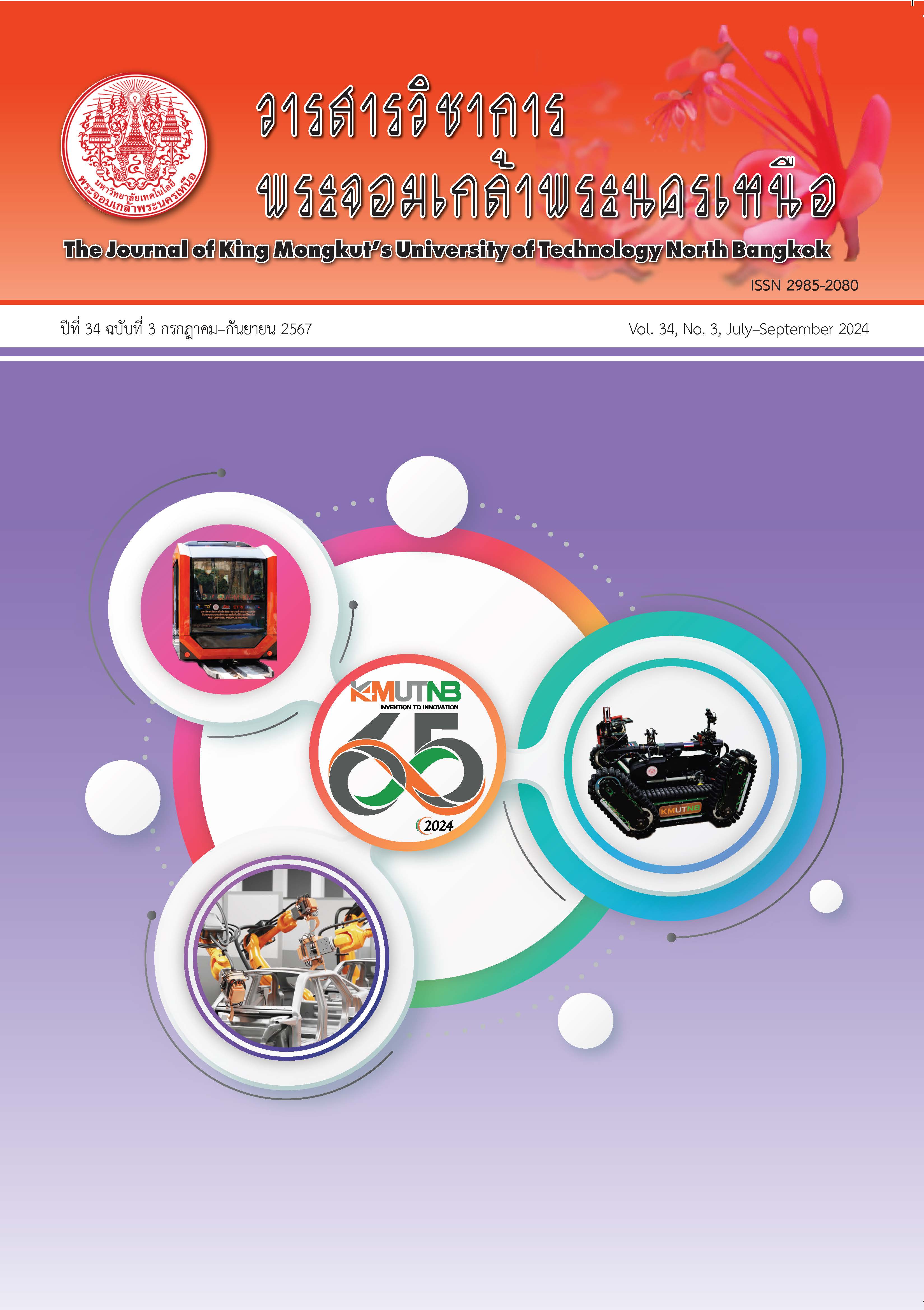One-step Production of Improved Performance Electrochromic NiO Film by Wet Chemical Method
Main Article Content
Abstract
The high-rise buildings mounted with glass windows to widen scenery of top view of the city become more popular nowadays. These causes the high energy consumption due to the air-condition system to lower the temperature inside the building according to high intensity of daylight penetration and global warming. The electrochromic smart window is one of the most promising ways to diminish the energy consumption. Particularly, nickel oxide is widely used in the electrochromic smart window. This research aims to synthesize nickel oxide film by wet chemical method, which is the simplest and inexpensive. The nickle hydroxide selected as the precursor was hydrolyzed in acid. Annealing temperature and film thickness were modified to achieve the high coloration efficiency. Moreover, the effects of the applied potential and film stability were examined. The results showed that the as-prepared NiO film annealed at 300 °C with the film weight of 10.32 mg is transparent. After applied voltage of 0.55 V vs. Hg/HgO, the film changed to brownish with the light transmission of 37.65%. On the contrary, the film turned to transparent with the light transmission of 86.34% after applied voltage of 0.35 V vs. Hg/HgO. These film exhibited the high coloration efficiency at 188.74 cm2/C. The ability to change in color raised to double after 190 cycles.
Article Details

This work is licensed under a Creative Commons Attribution-NonCommercial-NoDerivatives 4.0 International License.
The articles published are the opinion of the author only. The author is responsible for any legal consequences. That may arise from that article.
References
P. Jittiarporn, S. Badilescu, M. N. Al Sawafta, L. Sikong and V. V. Truong, “Electrochromic properties of sol–gel prepared hybrid transition metal oxides – A short review,” Journal of Science: Advanced Materials and Devices, vol. 2, no. 3, pp. 286–300, 2017.
G. Bo, X. Wang, K. Wang, R. Gao, B. Dong, L. Cao, and G. Su, “Preparation and electrochromic performance of NiO/TiO2 nanorod composite film,” Journal of Alloys and Compounds, vol. 728, pp. 878–886, 2017.
H. Lin, Z. Wang, Q. Han, R. Wang, L. Pan, H. Zhu, M. Wan and Y. Mai, “The growth, properties and application of reactively sputtered nickel oxide thin films in all thin film electrochromic devices,” Materials Science and Engineering: B, vol. 270, pp. 11596–11606, 2021.
M. Bonomo, “Synthesis and characterization of NiO nanostructures: A review,” Journal of Nanoparticle Research, vol. 20, pp. 1–26, 2018.
K. Zhou, Z.Qi, B. Zhao, S. Lu, H. Wang, J. Liu, and H. Yan, “The influence of crystallinity on the electrochromic properties and durability of NiO thin films,” Surfaces and Interfaces, vol. 6, pp. 91–97, 2017.
M. Shi, T. Qiu, B. Tang, G. Zhang, R. Yao, W. Xu, J. Chen, X. Fu, H. Ning, and J. Peng, “Temperature-controlled crystal size of wide band gap nickel oxide and Its application in electrochromism,” Micromachines, vol. 12, no. 1, pp. 80–91, 2021.
D.R. Sahu, T.J. Wu, S.C. Wang, and J.L. Huang, “Electrochromic behavior of NiO film prepared by e-beam evaporation,”Journal of Science: Advanced Materials and Devices, vol. 2, no. 2, pp. 225–232, 2017.
M. R. González-Siso, X. Gaona, L. Duro, M. Altmaier, and J. Bruno, “Thermodynamic model of Ni(II) solubility, hydrolysis and complex formation with ISA,” Radiochimica Acta, vol. 106, no. 1, pp.31–45, 2018.
X. Xie, C. Gao, X. Du, G. Zhu, W. Xie, P. Liu, and Z. Tang, “Improved optical and electrochromic properties of NiOx films by low-temperature spin-coating method based on NiOx nanoparticles,” Materials, vol. 11, no. 5, pp.760–772, 2018.
Y. Wu, Y. He, T. Wu, T. Chen, W. Weng, and H. Wan, “Influence of some parameters on the synthesis of nanosized NiO material by modified sol–gel method,” Materials Letters, vol. 61, no. 14–15, pp. 3174–3178, 2007.
M.M. Selim and N.A. Fathy, “Factors affecting the catalytic hydrogenation of p-nitrophenol by nano nickel supported on egyptian kaolin,” Egyptian Journal of Chemistry, vol. 55, no. 6, pp. 649–658, 2012.
F. T. Therma, E. Manikandan, A. Gurib-Fakim, and M. Maaza, “Single phase bunsenite NiO nanoparticles green synthesis by Agathosma betulina natural extract,” Journal of Alloys and Compounds, vol. 657, pp. 655–661, 2016.
G. Atak and O.D. Coskun, “Effects of anodic layer thickness on overall performance of all-solid-state electrochromic device,” Solid State Ionics, vol. 341, pp. 115045–115053, 2019.
T. Tatsuma, S. Saitoh, P. Ngaotrakanwiwat, Y. Ohka and A. Fujishima, “Energy storage of TiO2-WO3 photocatalysis systems in the gas phase,” Langmuir, vol. 18, pp. 7777–7779, 2002.
G. T. Phan, D. V. Pham, R. A. Patil, C. H. Tsai, C. C. Lai, W. C. Yeh, Y. Liou, and Y.R. Ma, “Fast-switching electrochromic smart windows based on NiO-nanorods counter electrode,” Solar Energy Materials and Solar Cells, vol.231, pp. 111306–111316, 2021.
A. Berlanga-Rodiguez, F. Avalos-Belmontes, M.A. Arvizu, C.R. Garcia, F.J. Rodriguez-Varela, E. Oyervides-Munoz and M.A. Garcia-Lobato, “Influence of the diameter of multi-walled carbon nanotubes on the electrochromic performance of NiO thin films,” Materials Letters, vol. 289, pp. 129403–129406, 2021.
P. W. Chen, C. T. Chang, T. F. Ko, S. C. Hsu, K. D. Li, and J. Y. Wu, “Fast response of complementary electrochromic device based on WO3/NiO electrodes,” Scientific Reports, vol. 10, pp. 8430–8441, 2020.
Q. Zhao, J. Wang, Y. Cui, X. Ai, Z. Chen, C. Cao, F. Xu, and Y. Gao, “The discovery of conductive ionic bonds in NiO/Ni transparent counter electrodes for electrochromic smart windows with an ultra-long cycling life,” Materials Advances, vol. 2, pp. 4667–4676, 2021.
Z. Zrikem, G. Song, A. A. Aghzzaf, M. Amjoud, D. Mezzane, and A. Rougier, “UV treatment for enhanced electrochromic properties of spin coated NiO thin films,” Superlattices and Microstructures, vol. 127, pp. 35–42, 2019.
C. Zhao, C. Chen, F. Du, and J. Wang, “Template synthesis of NiO ultrathin nanosheets using polystyrene nanospheres and their electrochromic properties,” RSC Advance, vol. 5, pp. 38533–38537, 2015.

